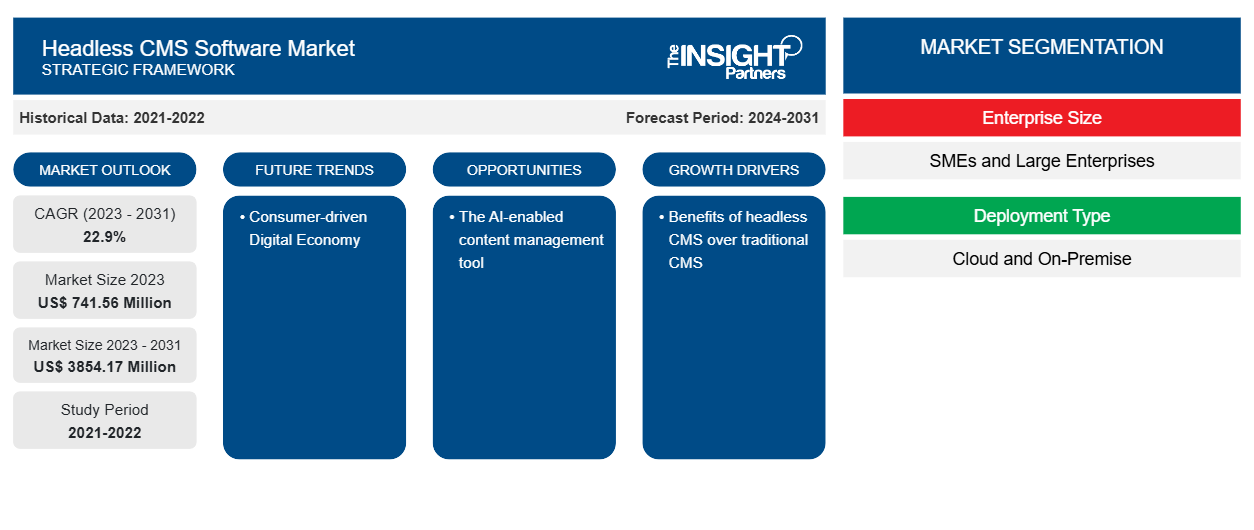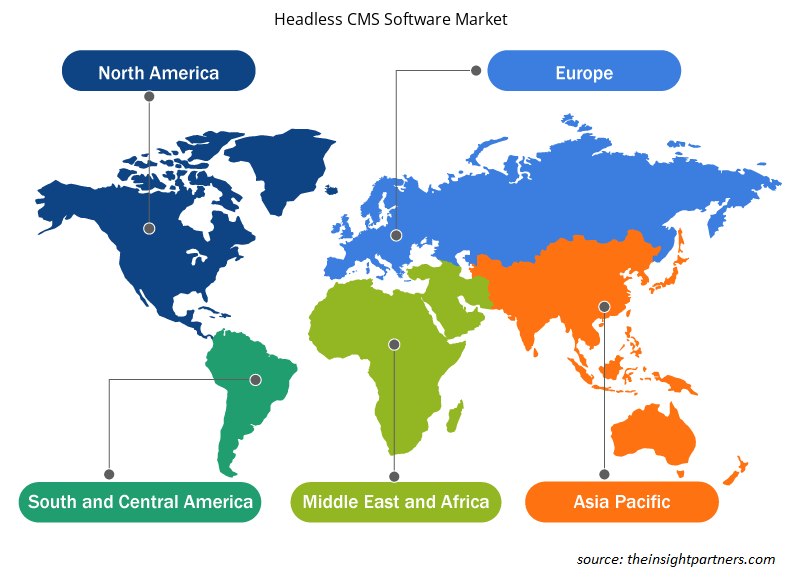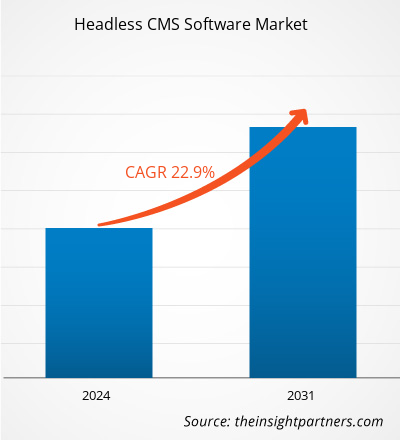The headless CMS software market size is projected to reach US$ 3854.17 million by 2031 from US$ 741.56 million in 2023. The market is expected to register a CAGR of 22.9% in 2023–2031. The rapid growth of digital content and the adoption of cloud-based technologies are likely to remain key to headless CMS software market trends.
Headless CMS Software Market Analysis
Adoption of headless CMS software leads to improved security and performance, and headless CMS may promote flexibility, scalability, and localization. This factor drives the headless CMS software market. The demand for headless CMS across various industries in developed and developing countries propels its market growth.
Headless CMS Software Market Overview
A headless CMS is a content management system that allows you to separate the front end from the back end. A CMS serves as a content repository in this architecture, and the content can be deployed on multiple platforms via an API. One of the primary benefits of headless CMS is its flexibility. With a traditional CMS, the frontend and backend are inextricably linked, so changes to the frontend affect changes to the backend, and vice versa. With headless CMS, the backend is separated from the frontend, allowing businesses to change their content and applications on the frontend without affecting the backend.
Customize This Report To Suit Your Requirement
You will get customization on any report - free of charge - including parts of this report, or country-level analysis, Excel Data pack, as well as avail great offers and discounts for start-ups & universities
Headless CMS Software Market: Strategic Insights

- Get Top Key Market Trends of this report.This FREE sample will include data analysis, ranging from market trends to estimates and forecasts.
You will get customization on any report - free of charge - including parts of this report, or country-level analysis, Excel Data pack, as well as avail great offers and discounts for start-ups & universities
Headless CMS Software Market: Strategic Insights

- Get Top Key Market Trends of this report.This FREE sample will include data analysis, ranging from market trends to estimates and forecasts.
Headless CMS Software Market Drivers and Opportunities
Consumer-driven Digital Economy to Favor Market
The consumer-driven digital economy has become the fundamental component of digital commerce strategies across industries. The consumer reaches companies or brands via a number of channels. This encourages companies to modernize their digital experience strategy to deliver true omnichannel experiences to meet the personalization demands of customers. Customer-centric content needs to be personalized, dynamic, and delivered at great speed. With the benefits of agility, flexibility, scalability, and personalization, headless CMS software can help companies enhance the customer experience.
Benefits of headless CMS over traditional CMS
A headless CMS offers greater flexibility over traditional CMS, as with the headless CMS, the content needs to be created once. It can be distributed to multiple channels and devices, including websites, smartwatches, mobile apps, IoT devices, and others. Headless CMS delivers content via APIs where the pages load at a greater speed more efficiently, whereas with the traditional CMS, each page requires trigger a server-side-render, which causes slow load time. Headless CMS is more secure than traditional CMS as they use advanced cloud-native technologies and they don’t expose the backend server to the internet. Thus, such several benefits of headless CMS over traditional CMS lead to the headless CMS software market growth.
Headless CMS Software Market Report Segmentation Analysis
Key segments that contributed to the derivation of the headless CMS software market analysis are ink deployment, organization size, monitoring type, and industry.
- By deployment, the market is segmented into on-premise and cloud. The cloud segment is expected to grow with the highest CAGR.
- Based on the enterprise size, the market is segmented into SMEs and large enterprises. The SMEs segment is expected to grow with the highest CAGR.
Headless CMS Software Market Share Analysis by Geography
The geographic scope of the headless CMS software market report is mainly divided into five regions: North America, Asia Pacific, Europe, Middle East & Africa, and South America/South & Central America.
Asia Pacific region is expected to grow with the highest CAGR. The proliferation of cloud technology in the region leads to the region’s market growth. The growing SMEs in the region fuel the demand for software solutions in the region, driving the use of synthetic monitoring technology. Digital transformation in emerging economies such as India and China leads to the adoption of synthetic monitoring solutions in various end-user industries.
Headless CMS Software Market Regional Insights
The regional trends and factors influencing the Headless CMS Software Market throughout the forecast period have been thoroughly explained by the analysts at The Insight Partners. This section also discusses Headless CMS Software Market segments and geography across North America, Europe, Asia Pacific, Middle East and Africa, and South and Central America.

- Get the Regional Specific Data for Headless CMS Software Market
Headless CMS Software Market Report Scope
| Report Attribute | Details |
|---|---|
| Market size in 2023 | US$ 741.56 Million |
| Market Size by 2031 | US$ 3854.17 Million |
| Global CAGR (2023 - 2031) | 22.9% |
| Historical Data | 2021-2022 |
| Forecast period | 2024-2031 |
| Segments Covered |
By Enterprise Size
|
| Regions and Countries Covered | North America
|
| Market leaders and key company profiles |
Headless CMS Software Market Players Density: Understanding Its Impact on Business Dynamics
The Headless CMS Software Market is growing rapidly, driven by increasing end-user demand due to factors such as evolving consumer preferences, technological advancements, and greater awareness of the product's benefits. As demand rises, businesses are expanding their offerings, innovating to meet consumer needs, and capitalizing on emerging trends, which further fuels market growth.
Market players density refers to the distribution of firms or companies operating within a particular market or industry. It indicates how many competitors (market players) are present in a given market space relative to its size or total market value.
Major Companies operating in the Headless CMS Software Market are:
- Agility Inc
- ButterCMS
- Contentful GmbH
- Contentstack Inc
- dotCMS LLC
- Hygraph GmbH
Disclaimer: The companies listed above are not ranked in any particular order.

- Get the Headless CMS Software Market top key players overview
Headless CMS Software Market News and Recent Developments
The Headless CMS Software Marketis evaluated by gathering qualitative and quantitative data post primary and secondary research, which includes important corporate publications, association data, and databases. The following is a list of developments in the market:
- In June 2023, aurastride, the latest addition to the Vsourz product offering, is aiming to disrupt the travel industry with its launch as a cutting-edge headless CMS platform. This innovative solution is set to transform the way travel businesses manage content and deliver personalized experiences, while also offering a seamless integration with the highly acclaimed moonstride travel industry SAAS platform. (Source: moonstride, Press Release, 2023)
Headless CMS Software Market Report Coverage and Deliverables
The “Headless CMS Software Market Size and Forecast (2021–2031)” report provides a detailed analysis of the market covering below areas:
- Market size and forecast at global, regional, and country levels for all the key market segments covered under the scope
- Market dynamics such as drivers, restraints, and key opportunities
- Key future trends
- Detailed PEST/Porter’s Five Forces and SWOT analysis
- Global and regional market analysis covering key market trends, major players, regulations, and recent market developments
- Industry landscape and competition analysis covering market concentration, heat map analysis, prominent players, and recent developments
- Detailed company profiles
Frequently Asked Questions
What is the estimated market size for the global headless CMS software market in 2023?
The global headless CMS software market was estimated to be US$ 741.56 million in 2023 and is expected to grow at a CAGR of 22.9% during the forecast period 2023 - 2031.
What are the driving factors impacting the global headless CMS software market?
The rapid growth of digital content and the adoption of cloud-based technologies are the major factors that propel the global headless CMS software market.
What are the future trends of the global headless CMS software market?
The AI-enabled content management tool is anticipated to play a significant role in the global headless CMS software market in the coming years.
Which are the key players holding the major market share of the global headless CMS software market?
The key players holding majority shares in the global headless CMS software market are Agility Inc., ButterCMS, Contentful GmbH, Contentstack Inc., and dotCMS LLC.
What will be the market size of the global headless CMS software market by 2031?
The global headless CMS software market is expected to reach US$ 3854.17 million by 2031.
What is the incremental growth of the global headless CMS software market during the forecast period?
The incremental growth expected to be recorded for the global headless CMS software market during the forecast period is US$ 3112.61 million.
- Historical Analysis (2 Years), Base Year, Forecast (7 Years) with CAGR
- PEST and SWOT Analysis
- Market Size Value / Volume - Global, Regional, Country
- Industry and Competitive Landscape
- Excel Dataset
- Parking Meter Apps Market
- eSIM Market
- Advanced Distributed Management System Market
- Online Exam Proctoring Market
- Electronic Data Interchange Market
- Barcode Software Market
- Maritime Analytics Market
- Cloud Manufacturing Execution System (MES) Market
- Robotic Process Automation Market
- Digital Signature Market
Testimonials
Reason to Buy
- Informed Decision-Making
- Understanding Market Dynamics
- Competitive Analysis
- Identifying Emerging Markets
- Customer Insights
- Market Forecasts
- Risk Mitigation
- Boosting Operational Efficiency
- Strategic Planning
- Investment Justification
- Tracking Industry Innovations
- Aligning with Regulatory Trends
Yes! We provide a free sample of the report, which includes Report Scope (Table of Contents), report structure, and selected insights to help you assess the value of the full report. Please click on the "Download Sample" button or contact us to receive your copy.
Absolutely — analyst assistance is part of the package. You can connect with our analyst post-purchase to clarify report insights, methodology or discuss how the findings apply to your business needs.
Once your order is successfully placed, you will receive a confirmation email along with your invoice.
• For published reports: You’ll receive access to the report within 4–6 working hours via a secured email sent to your email.
• For upcoming reports: Your order will be recorded as a pre-booking. Our team will share the estimated release date and keep you informed of any updates. As soon as the report is published, it will be delivered to your registered email.
We offer customization options to align the report with your specific objectives. Whether you need deeper insights into a particular region, industry segment, competitor analysis, or data cut, our research team can tailor the report accordingly. Please share your requirements with us, and we’ll be happy to provide a customized proposal or scope.
The report is available in either PDF format or as an Excel dataset, depending on the license you choose.
The PDF version provides the full analysis and visuals in a ready-to-read format. The Excel dataset includes all underlying data tables for easy manipulation and further analysis.
Please review the license options at checkout or contact us to confirm which formats are included with your purchase.
Our payment process is fully secure and PCI-DSS compliant.
We use trusted and encrypted payment gateways to ensure that all transactions are protected with industry-standard SSL encryption. Your payment details are never stored on our servers and are handled securely by certified third-party processors.
You can make your purchase with confidence, knowing your personal and financial information is safe with us.
Yes, we do offer special pricing for bulk purchases.
If you're interested in purchasing multiple reports, we’re happy to provide a customized bundle offer or volume-based discount tailored to your needs. Please contact our sales team with the list of reports you’re considering, and we’ll share a personalized quote.
Yes, absolutely.
Our team is available to help you make an informed decision. Whether you have questions about the report’s scope, methodology, customization options, or which license suits you best, we’re here to assist. Please reach out to us at sales@theinsightpartners.com, and one of our representatives will get in touch promptly.
Yes, a billing invoice will be automatically generated and sent to your registered email upon successful completion of your purchase.
If you need the invoice in a specific format or require additional details (such as company name, GST, or VAT information), feel free to contact us, and we’ll be happy to assist.
Yes, certainly.
If you encounter any difficulties accessing or receiving your report, our support team is ready to assist you. Simply reach out to us via email or live chat with your order information, and we’ll ensure the issue is resolved quickly so you can access your report without interruption.





















 Get Free Sample For
Get Free Sample For